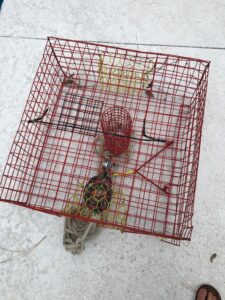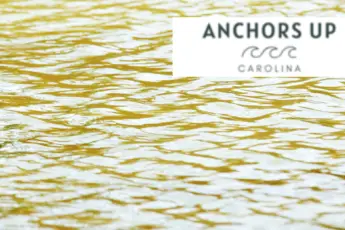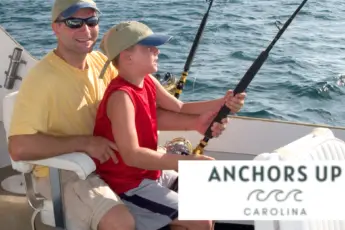Blue crab is one of the most tasty crustaceans in the coastal waters of Georgia, South Carolina, and North Carolina. I have caught blue crabs by the bucket load while standing on a dock. One of the most effective approaches is using a blue crab trap. Here is what you need to know about a blue crab trap.
What Is A Crab Trap
Not all crab traps are the same. However, in the end they all serve the same purpose: to catch crabs.
First, let’s start with the shape. Crab traps are rectangular or square, depending on the model. I have owned multiple traps, and each differs slightly, but the differences are minimal.
Second, What is most recognizable is quality. Some are flimsy, while others are more sturdy and capable of withstanding the harsh salt environment. For example, one trap rotted away within two years’ time because the metal composing the trap was not coated in vinyl.
How Does A Blue Crab Trap Work
The simplicity of a blue crab trap is hard to fathom. It is hard to fathom that such a simple design yields excellent results in catching copious amounts of delicious crustaceans.
Let’s start by saying that a crab trap lowered into coastal waters without bait is rendered ineffective. Therefore, all traps are fitted with a bait holder. The bait holder is often located in the center, so it is farther from the entrances.
On each end of the trap is an opening. The opening measures up to six inches wide and two inches high. In technical terms, the openings are called throats. The design of the throat allows the crab to enter but does not allow them to exit.
One primary concern with blue crab traps is accidental captures of terrapin turtles. While terrapin turtles are not endangered, they are listed as threatened. Unfortunately, turtles enter the trap, are unable to escape and drown. For this reason, turtle excluding devices were designed. The excluding device is a rectangular piece of plastic positioned on the trap’s exterior. One is on the outside of each opening. Zip ties secure the excluding devices. The device’s purpose is to prevent turtles from entering, as the opening is large enough for crabs but blocks out terrapin turtles.

The crabs enter the trap only because of the food positioned at the center. The scent attracts blue crabs from a distance.
Another critical component of a blue crab trap is cull rings. Cull rings are small circular openings. Depending on the model, it may be fitted with one or more cull rings. The purpose of the cull ring is to allow blue crabs below legal harvesting size to escape from the trap.
What Is The Best Bait For Blue Crab Traps
Take it from me; the options for the type of bait for crab traps are endless. I have had great success catching blue crabs with a multitude of varieties.
Without a doubt, the most effective baits are chicken necks. Chicken necks are dense and thick for this reason, they outlast other varieties of baits. Generally speaking, a crab trap holds three to four chicken necks.
The next best bait for a blue crab trap is fish carcasses. After a day of fishing, I have used fish carcasses and found them highly effective. Depending on the size of the fish, one to two fish carcasses will fill the bait holder of a crab trap.
Conversely, I do not recommend using shrimp or small bait fish. The shrimp and small baitfish quickly break down and escape through the openings of the enclosure. Remember, the goal is for the bait to last versus rapidly decompose. The longer the bait lasts, the better the results.

What Time Of Day Are Blue Crabs Most Active
I have caught blue crabs day and night with equal success. However, the blue crab is most active during the nighttime hours.
During the night, significant populations of blue crabs move out of hiding and go on the hunt for food. Importantly, blue crab traps, by law, can only be left for up to 24 hours. Therefore, no matter the time of day you set the trap, it can be left in the water with bait during the night.
While yes, technically, blue crabs are more active at night, I have caught plenty of them during the daylight hours. Furthermore, I watched dozens of blue crabs move about in the water when peering from a dock above on a single visit.
To conclude, what time of day are blue crabs most active? Take it from me; you will catch crabs at any time.
What Is The Best Depth To Catch Blue Crabs
When fishing for blue crabs with a trap, I highly recommend focusing on water that measures between four and ten feet.
Without a doubt, take into consideration tidal changes. What was four feet at high tide is likely to be high and dry during low tide. Always set a trap where it will remain in the water during low tide, or else you will arrive at a basket full of dead crabs.
I prefer to deploy my blue crab traps in locations where they remain one foot beneath the surface during low tide. The reason for this is blue crab activity. The crabs are highly active in shallow water searching for food and therefore enter the trap in abundance.
Drop In A Blue Crab Trap To Catch Tasty Crustaceans
It almost seems unfathomable that such a simple design yields such success. Without a doubt loading up on blue crabs is made simple with a blue crab trap. You may catch them by the bushel. Additionally, crabbing is a fun family event that will keep the kids entertained. Lastly, always check the regulations of your state to remain in compliance with the law.








